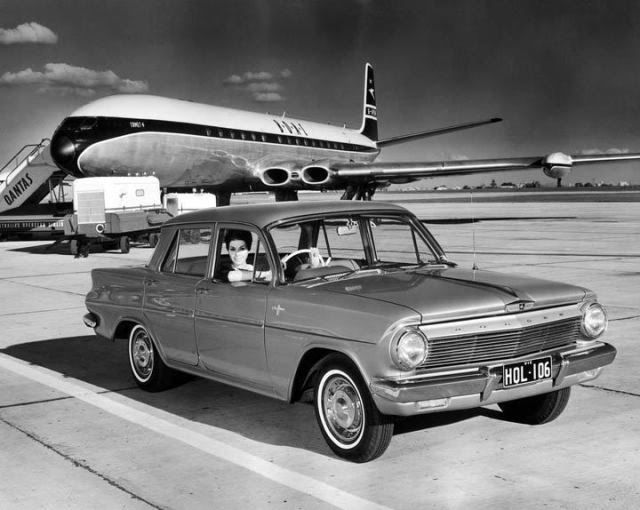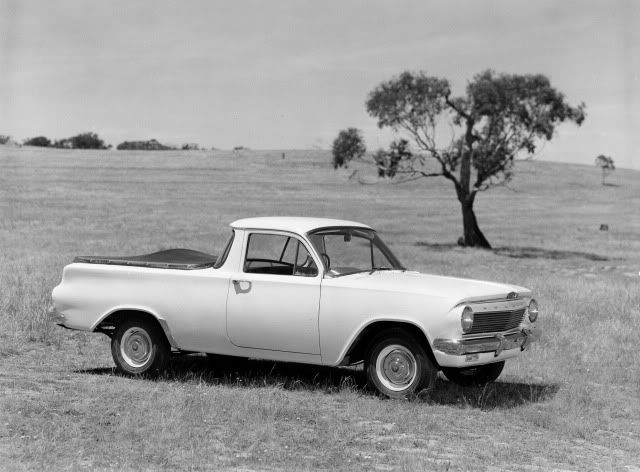Holden now has a car for the Sixties: gone is the EK, the last incarnation of the FE originally launched in 1956. In its place now stands the EJ, an automobile designed as a typical Australian saloon, not a shrunk American sedan as the FE has been. This new approach seems a clever in order to counter Holden’s challengers, the Ford Falcon and the Chrysler Valiant, both based on the newest compact designs originated in the United States.
Once again this year, the entry-level offering is the Standard, though its place as the mainstream Holden model is now taken by the Special, pushing it down as the car of choice for taxi and other fleet operators.
Holden Standard
Based on the German Opel Kapitän, the EJ looks lower and wider, and many small improvements in its equipment help make forget the rather utilitarian appearance of the original Holdens. “Hydramatic” automatic transmission is now available throughout the range, and standard power brakes are a welcome addition. Lift the bonnet, and the EJ looks rather like the previous FE/EK, though.
● Introduction: July 1962. Construction: monocoque. Engine: water-cooled inline six, 2.3-litre, 75 hp, mounted at the front. Transmission: to the rear wheels through a three-speed manual gearbox. Three-speed automatic gearbox optional. Suspension: independent at the front, rigid axle at the rear. Brakes: hydraulic, to drums on all four wheels, with servo. Length: 449 cm. Top speed: 130 kph. Range: four-door sedan, four-door station sedan.
Holden Special
This Special used to be Holden’s top-of-the-line model, but has now lost this honour to the new Premier. It is still a very desirable car to the eyes of an Australian motorist.

● Introduction: July 1962. Construction: monocoque. Engine: water-cooled inline six, 2.3-litre, 75 hp, mounted at the front. Transmission: to the rear wheels through a three-speed manual gearbox. Three-speed automatic gearbox optional. Suspension: independent at the front, rigid axle at the rear. Brakes: hydraulic, to drums on all four wheels, with servo. Length: 449 cm. Top speed: 130 kph. Range: four-door sedan, four-door station sedan.
Holden Premier
Available only as a saloon, the new luxury Premier offers such refinements as separate leather seats rather than the bench-type ones used on lesser models, a centre console and an array of minor additional equipments.

● Introduction: July 1962. Construction: monocoque. Engine: water-cooled inline six, 2.3-litre, 75 hp, mounted at the front. Transmission: to the rear wheels through a three-speed manual gearbox. Three-speed automatic gearbox optional. Suspension: independent at the front, rigid axle at the rear. Brakes: hydraulic, to drums on all four wheels, with servo. Length: 449 cm. Top speed: 130 kph. Range: four-door sedan.
Holden Commercial
The range of commercial vehicles Holden based on its passenger cars again includes a pickup and a panel van, introduced a few months after the rest of the line-up.

● Introduction: January 1963. Construction: monocoque. Engine: water-cooled inline six, 2.3-litre, 75 hp, mounted at the front. Transmission: to the rear wheels through a three-speed manual gearbox. Three-speed automatic gearbox optional. Suspension: independent at the front, rigid axle at the rear. Brakes: hydraulic, to drums on all four wheels, with servo. Length: 449 cm. Top speed: 130 kph. Range: two-door utility pickup, two-door panel van.
Any mistake you’ve just spotted? A detail to add? A suggestion? Don’t hesitate to leave a comment!
Click to jump to another model year of the same car: 1963 – 1964 – 1965
Click here to return to a list of all Holden vehicles presented on this blog.
Click here to return to this blog’s initial post, featuring a list of all vehicles already presented.
Once again this year, the entry-level offering is the Standard, though its place as the mainstream Holden model is now taken by the Special, pushing it down as the car of choice for taxi and other fleet operators.
Holden Standard
Based on the German Opel Kapitän, the EJ looks lower and wider, and many small improvements in its equipment help make forget the rather utilitarian appearance of the original Holdens. “Hydramatic” automatic transmission is now available throughout the range, and standard power brakes are a welcome addition. Lift the bonnet, and the EJ looks rather like the previous FE/EK, though.
● Introduction: July 1962. Construction: monocoque. Engine: water-cooled inline six, 2.3-litre, 75 hp, mounted at the front. Transmission: to the rear wheels through a three-speed manual gearbox. Three-speed automatic gearbox optional. Suspension: independent at the front, rigid axle at the rear. Brakes: hydraulic, to drums on all four wheels, with servo. Length: 449 cm. Top speed: 130 kph. Range: four-door sedan, four-door station sedan.
Holden Special
This Special used to be Holden’s top-of-the-line model, but has now lost this honour to the new Premier. It is still a very desirable car to the eyes of an Australian motorist.

● Introduction: July 1962. Construction: monocoque. Engine: water-cooled inline six, 2.3-litre, 75 hp, mounted at the front. Transmission: to the rear wheels through a three-speed manual gearbox. Three-speed automatic gearbox optional. Suspension: independent at the front, rigid axle at the rear. Brakes: hydraulic, to drums on all four wheels, with servo. Length: 449 cm. Top speed: 130 kph. Range: four-door sedan, four-door station sedan.
Holden Premier
Available only as a saloon, the new luxury Premier offers such refinements as separate leather seats rather than the bench-type ones used on lesser models, a centre console and an array of minor additional equipments.

● Introduction: July 1962. Construction: monocoque. Engine: water-cooled inline six, 2.3-litre, 75 hp, mounted at the front. Transmission: to the rear wheels through a three-speed manual gearbox. Three-speed automatic gearbox optional. Suspension: independent at the front, rigid axle at the rear. Brakes: hydraulic, to drums on all four wheels, with servo. Length: 449 cm. Top speed: 130 kph. Range: four-door sedan.
Holden Commercial
The range of commercial vehicles Holden based on its passenger cars again includes a pickup and a panel van, introduced a few months after the rest of the line-up.

● Introduction: January 1963. Construction: monocoque. Engine: water-cooled inline six, 2.3-litre, 75 hp, mounted at the front. Transmission: to the rear wheels through a three-speed manual gearbox. Three-speed automatic gearbox optional. Suspension: independent at the front, rigid axle at the rear. Brakes: hydraulic, to drums on all four wheels, with servo. Length: 449 cm. Top speed: 130 kph. Range: two-door utility pickup, two-door panel van.
Any mistake you’ve just spotted? A detail to add? A suggestion? Don’t hesitate to leave a comment!
Click to jump to another model year of the same car: 1963 – 1964 – 1965
Click here to return to a list of all Holden vehicles presented on this blog.
Click here to return to this blog’s initial post, featuring a list of all vehicles already presented.
No comments:
Post a Comment